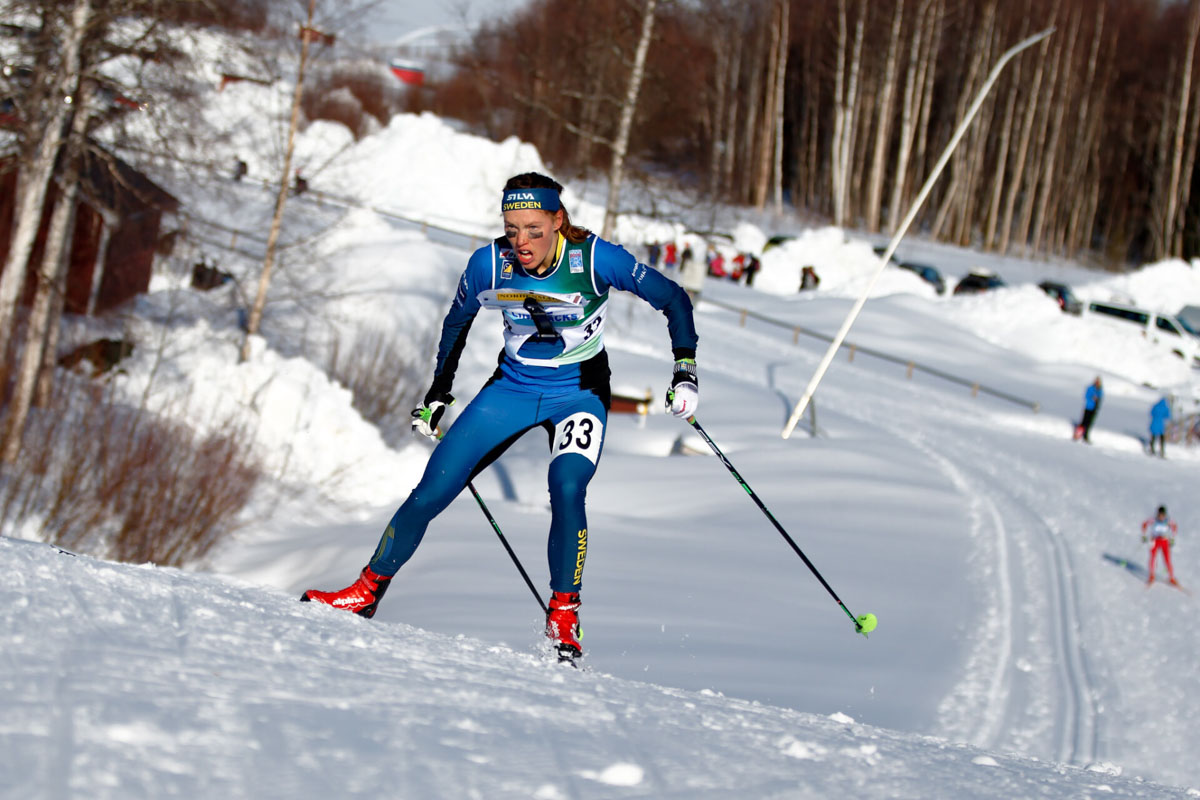It wasn’t long after Sweden’s Tove Alexandersson won the 2025 Trail World Championships Short Trail race in late September — with a large bandage across her forehead from a fall on the same course just three weeks prior that required stitches — that she was off to Bormio, Italy, for a training camp with the Swedish national team, this time for ski mountaineering instead of trail running. The national team was spending two weeks high on the Stelvio glacier in preparation for a trip to the U.S. to try to qualify for the 2026 Olympic Games in Italy. While most athletes from the World Mountain and Trail Running Championships were back home relaxing after a season of racing, Alexandersson was doing 10- to 20-second intervals on skis to build speed for much shorter races. Alexandersson quips about the fast turnaround time and minimal recovery between sports, “It was nice to get some skiing and not just running. So at least it’s some rest from running.”
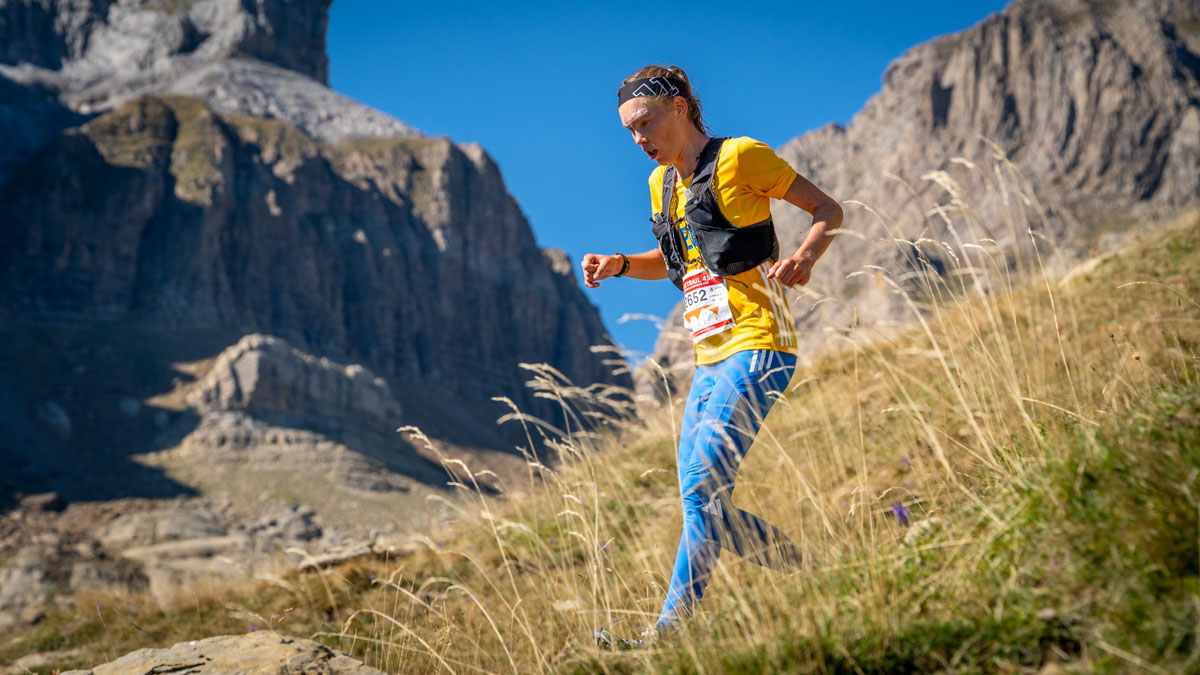
Tove Alexandersson on her way to winning the 2025 Trail World Championships Short Trail in Canfranc, Spain. Photo: iRunFar/Eszter Horanyi
While Alexandersson was still somewhat under the radar in the trail running world before her dominant win at the women’s 2025 Trail World Championships Short Trail — she was 17th overall and almost 34 minutes ahead of the second-place woman — she’s been a world-class athlete in other sports nearly her entire life. At 33 years old, she’s won world championship titles in six different sports, ranging from skyrunning to ski orienteering to snowrunning, and is currently tied for the most successful foot orienteer with 23 world titles, 11 of them won consecutively. The difficulty in doing a variety of different sports well doesn’t seem to faze her, and she laughs when she says, “I’ve done it all my life, changing between different sports.”
While all of her other activities have taken the runner-up spot to orienteering thus far, it seems that maybe the 2025 Trail World Championships Short Trail — perhaps the first trail race that Alexandersson has truly made a priority in her training — might be a turning point for her. After all, she says, “The most important for me is to enjoy the training,” and when asked what her favorite type of training is, she’s quick to say, “I really like to run up to mountain summits.” She adds, “Also, fast running.”
If Alexandersson’s win is any indication of what she can do when she focuses more than a few days or weeks on preparing for a trail race outside of her other sport seasons, it’s easy to imagine what else she could do.
Growing Up Orienteering
While to the outside world, Sweden might be associated with excellence in cross-country skiing, according to Alexandersson, orienteering is the nation’s every person’s sport, and one that people of all ages participate in. She says, “Both my parents have been running orienteers since they were kids. So I grew up with orienteering, and I was in my first orienteering race when I was around one year old. Orienteering has always been in my life.” Alongside her family’s participation in the sport — something her grandparents also did, making it a truly multigenerational activity — Alexandersson also enjoyed other sports, such as cross-country skiing, biking, and running.
For those unfamiliar with orienteering, participants receive a map with a set of marked waypoints, often in an area where they’ve never been before. They must navigate to those spots using just a compass, choosing their own routes through the terrain. Most races range from as short as eight minutes to two hours. There are a handful of events throughout the world that are longer, and some that are held at night.
Alexandersson’s brothers, one older and one younger, were also orienteers, and she credits her older brother for some of her early success in the sport, saying, “I always wanted to do the same as him. So I was quite early with everything. I was in front already as a kid.”
Alexandersson is quick to point out that while it was ultimately orienteering that caught her full attention, it really could have been anything. “I have always had this competitive side, that I want to win races. I have also always really liked to train a lot and challenge myself, so I think I would have ended up with some kind of sport.”
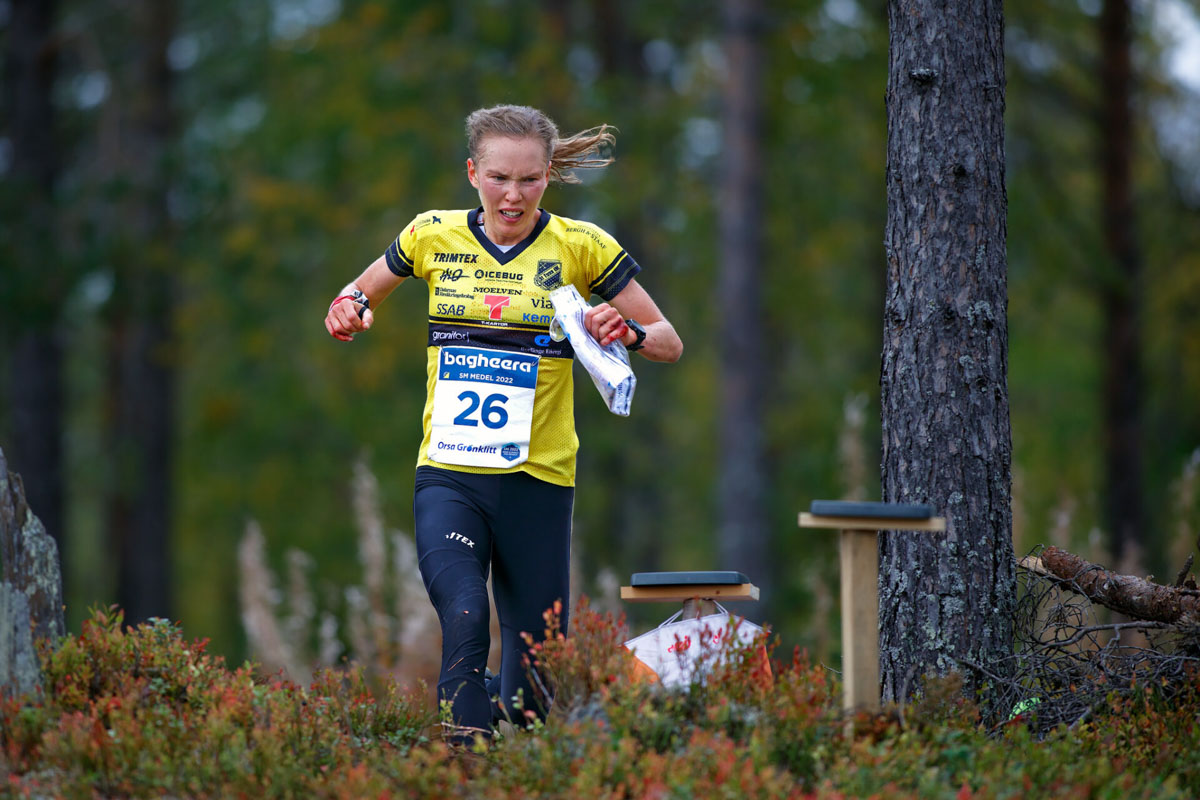
Alexandersson reaching a checkpoint at the 2022 Orsa Grönklitt orienteering race. Photo: Sven Alexandersson
Even early on, Alexandersson enjoyed the multifaceted nature of orienteering, as it had both the physical aspect of moving through terrain efficiently and the intellectual side of looking at a map, visualizing what terrain looked like based on topographic lines, and making decisions on how to move efficiently from one spot to the next. Alexandersson says that as a child, “I was really focused on the orienteering technique, and that was the part I enjoyed most, reading the map to really understand.” She goes on to explain, “I also walked a lot in the forest, so I built up a really good base with orienteering technique at an early age.”
Roaming around in the woods with a map and compass, Alexandersson never really considered that she could become a professional orienteer. She says, “I thought that after high school, I would need to continue my education and start working.” But she found success in the sport early and never looked back. When she was just 16, she became the 2009 junior world champion in the middle distance event at the World Orienteering Championships and defended the title in 2010 and 2012. When the chance arose to continue racing, she went for it. “Everything went so fast, and I took the opportunity to try to do it professionally. I got some sponsors and also some prize money.” Sitting in a hotel room in Italy in the fall of 2025, training for the upcoming ski mountaineering season and relaying the story, she smiles when she says, “I really enjoy life as a professional athlete. So yeah, I’m still here.”
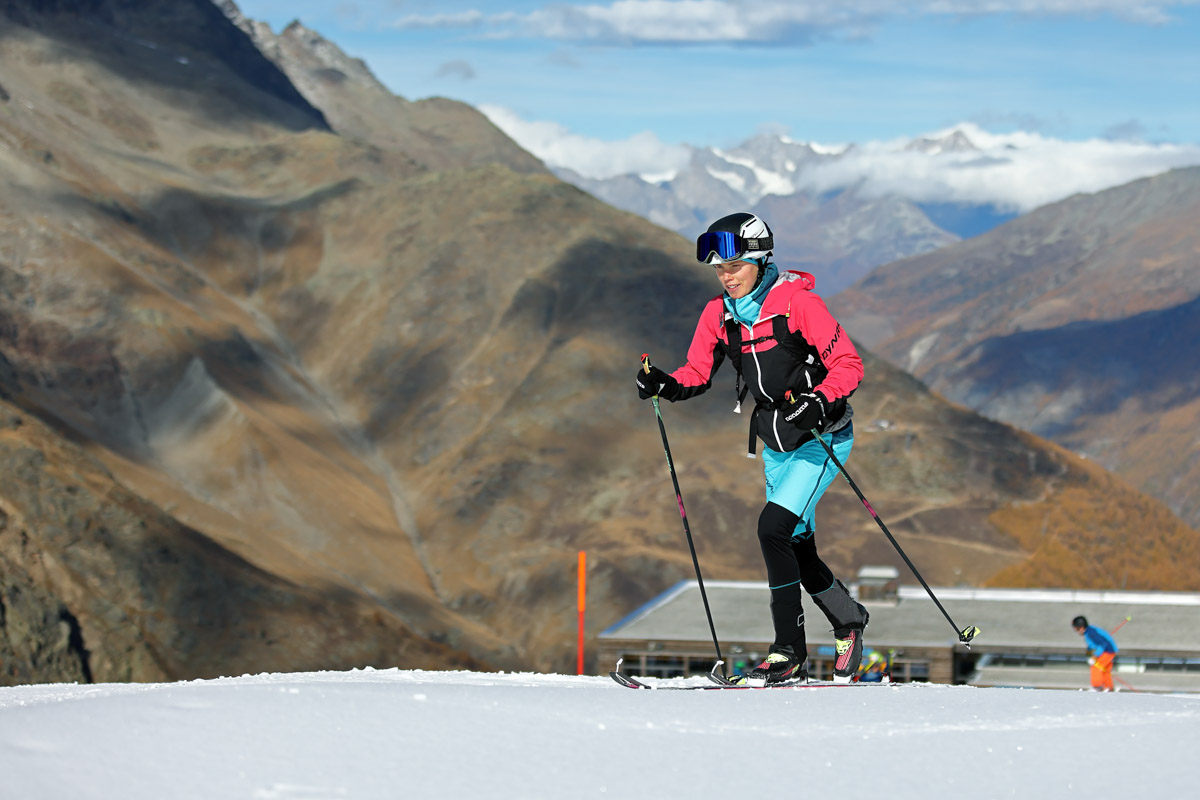
During the winter months, ski mountaineering is just one of the sports that Alexandersson races. Photo: Sven Alexandersson
Even after more than 30 years of going to events, Alexandersson is still dedicated to the sport, saying, “In orienteering, it’s so many details, so you can improve all the time. I really like that it feels like you are never done. You can always be better.”
Lure of the Mountains
It’s not that Alexandersson actively chose orienteering over trail running; it was just the sport that she was immersed in daily. While she lived in an area lacking high mountains, she was fascinated by the idea of them. She says, “When I’d been on vacation somewhere with high mountains, I always liked to run in them and climb them.” She says that when she was younger, “I didn’t know that you could compete in running up and down mountains.”
But the orienteering race season stretched from April through October, with races multiple times a month, and there simply wasn’t time to pursue trail racing in any serious manner. It wasn’t until she was 25 years old that Alexandersson signed up for her first trail race, the 2017 Limone Extreme skyrace. The mid-October event took place after the orienteering season, and Alexandersson was on vacation in Italy with some friends when she decided to sign up.
“I wasn’t prepared for the race at all,” she admits. “My body was totally destroyed afterward.” Still, she came away with the win by nearly 12 minutes in the 3.5-hour race after taking several falls on the final descent. “I had to go in a wheelchair for some days, and when I came home, I couldn’t stand on my legs at all for a week,” she says. “The thick skin under the heels and under the toes was totally gone, and also my ankles were super swollen.” She goes on to say wryly, “Of course, my legs and muscles were destroyed as well, but I didn’t feel that so much because I couldn’t use the muscles anyway because I couldn’t stand.”
Coming from much shorter orienteering races, Alexandersson’s nutrition plan also lacked sophistication. She says, “I thought it would be enough to have two really small gels, and I had no sports drinks or anything at all, and I wasn’t eating anything at the aid stations.” Unsurprisingly, she says, “I was out of energy in the end.”
While Alexandersson says that upon crossing that finish line, she swore never to do a trail race again, it only took her three days to start looking at the calendar to see what event would fit in next. Ever the student of sport, Alexandersson was determined to learn from her mistakes and try again.
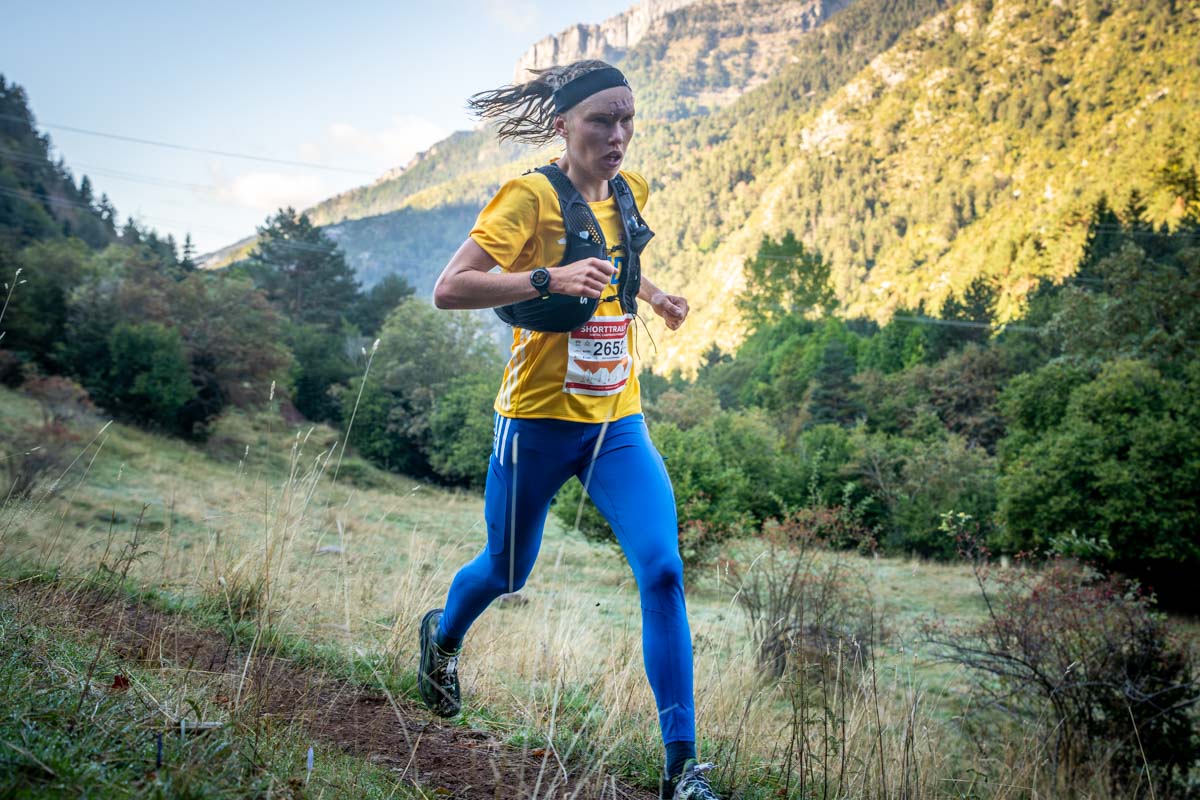
Alexandersson leading the 2025 Trail World Championships Short Trail after the first climb and descent. Photo: iRunFar/Eszter Horanyi
When she won the 2018 Ring of Steall Skyrace in Scotland the following year, she’d trained specifically for running in the two weeks leading up to the event and said, “I had many more gels with me so I could have energy all the way to the finish.”
She also returned to the Limone Extreme skyrace that year and won it again.
Dabbling in Trail
Even with her success in trail racing, Alexandersson kept her focus on orienteering. She says that while she knew trail racing was more popular on a global scale than orienteering, it wasn’t as popular in Sweden. Over the coming years, she’d fit in a late-season trail race when she could, winning events like the 2020 Volcanoes Trail 23k in Portugal, which was the Golden Trail World Series finals for that year.
In 2022, she was selected as part of Team Sweden to compete at the Trail World Championships Short Trail in Thailand, but was unable to race due to injury. In 2023, she was again selected to represent Team Sweden at the World Mountain and Trail Running Championships, but the event — held in June in Innsbruck, Austria — was in the middle of orienteering season, and Alexandersson was fully focused on the World Orienteering Championships later that year.
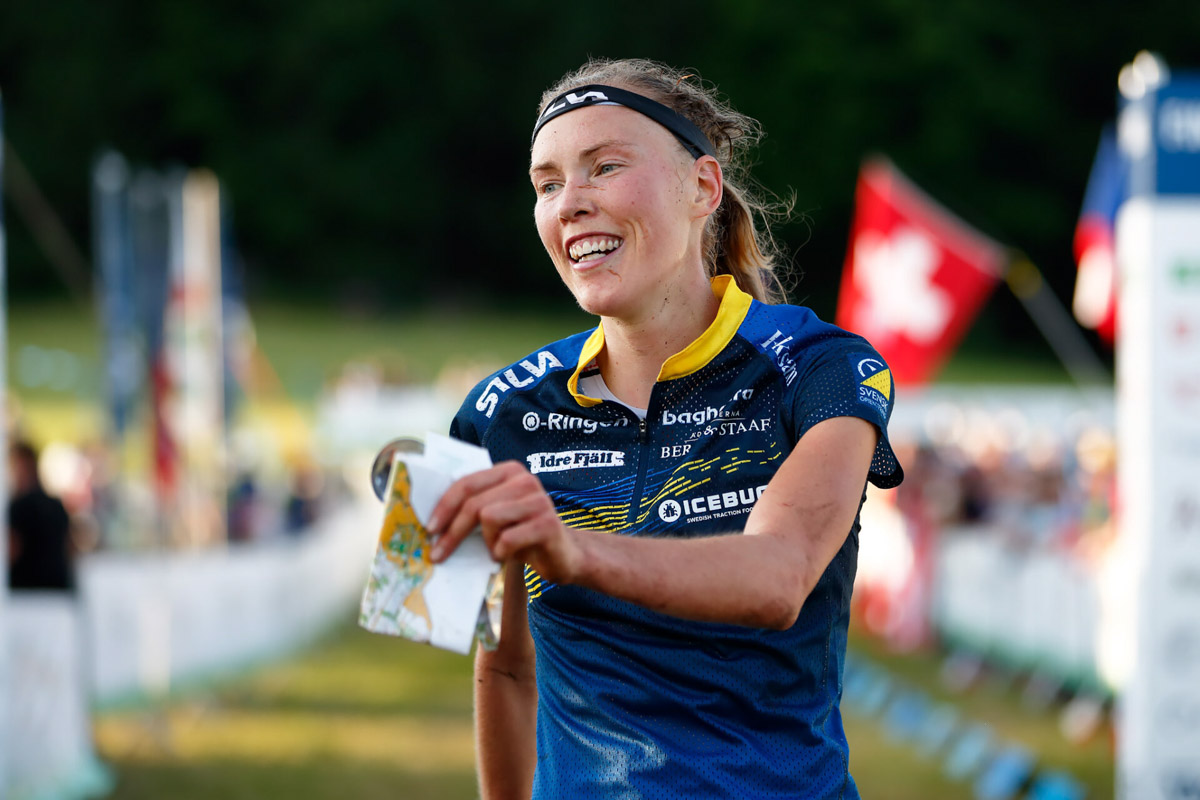
Alexandersson winning the 2021 World Orienteering Championships Middle Distance event. Photo: Sven Alexandersson
Not wanting to risk injury or interrupt her training, she opted to race the shorter World Mountain Running Championships Up and Down race instead of the longer Trail World Championships Short Trail. Additionally, she was living in Austria at the time, and the event required minimal travel. She says, “I was thinking it will be good preparation for the World Orienteering Championships and it will be fun to run on my home ground.”
After placing second at the race, she says, “I was actually really surprised. Afterward, I was like, ‘I should do it again but have better preparations and see how good I can be.’”
The 2025 Canfranc-Canfranc Marathon
Alexandersson took her preparation for the 2025 Trail World Championships Short Trail seriously and went to Canfranc, Spain, the small host village nestled deep in the Spanish Pyrenees, for a training camp with Team Sweden three weeks ahead of the event to recce the course and get in some quality training. While out on the course, she started to notice flagging, and after some Googling, Alexandersson discovered that the long-running Canfranc-Canfranc Marathon was happening that weekend on the same course.
With only a bit of hesitation, she signed up and says, “I was thinking, ‘Is it good for me to run it or is it just stupid?’ But I was a bit curious to see how I would handle the distance because I had never run such a long race before. I was a little bit nervous that I didn’t know what kind of tactics I should have.” She goes on to explain, “I was thinking that maybe it can be good for me just to test everything and see how it works, so I know what to do.”
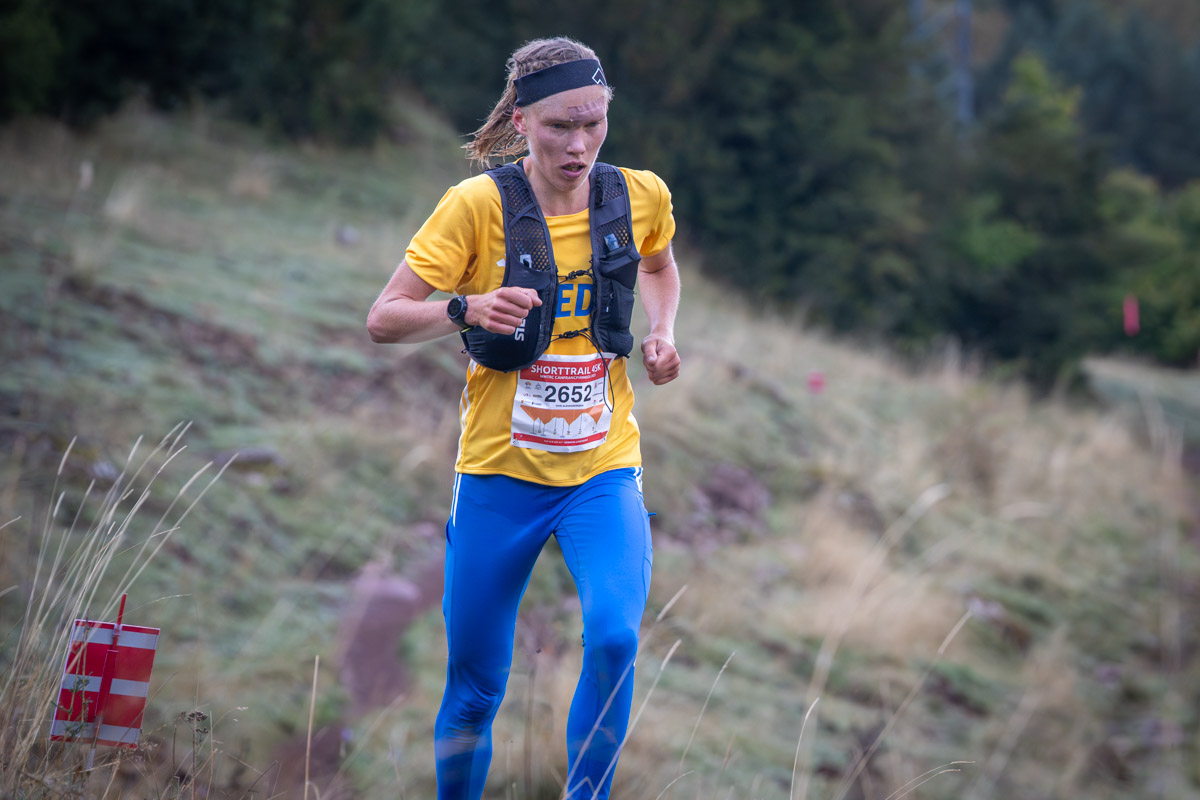
Alexandersson racing the 2025 Trail World Championships Short Trail with a bandage on her forehead from a fall on the same course three weeks prior. Photo: iRunFar/Eszter Horanyi
On race day, things were going well until the second descent, a steep slope down a ski area with tall grasses and lots of hidden rocks. Alexandersson took a tumble while leading the race, cutting open her forehead and bleeding profusely. She says, “My first thought was just, ‘Now I have to quit the race. Why should I fall? I really wanted to run the whole course!’” When she decided that maybe the cut wasn’t as bad as the blood indicated, she got annoyed at the situation, thinking, “I’m losing a lot of time just sitting here trying to stop the bleeding.” When she made it to the aid station and into the back of an ambulance for medical care, she immediately asked if she’d be allowed to continue. After examining her head and stitching her up — a process that took under 20 minutes — the medical team let Alexandersson head back out on course, and she won the race with a new course record time.
She credits some of her ability to recover quickly after the race to the fall, saying, “I wasn’t going full speed after I’d been in the ambulance. I took it a little bit easier on the last part.”
2025 Trail World Championships Short Trail and Beyond
Alexandersson arrived at the start line of the Trail World Championships Short Trail in exceptional shape and led from the start, opening up a three-minute gap on the rest of the women’s field by the top of the first climb, 6.6 kilometers (4.1 miles) with nearly 1,500 meters (5,000 feet) of climbing. By the time she made it down the descent where she’d fallen three weeks earlier — a stretch of trail where she admits, “I was careful there and when I had no falls, I was quite happy thinking, ‘Ok, at least it’s better than last time’” — she was almost 20 minutes in the lead.
She ran strongly and consistently throughout, and while she knew she had a big gap, she never let up. She says, “I had no problems or struggles at all. I don’t think it could have been so much better.”

The 2025 Trail World Championships Short Trail was the first trail event that Alexandersson dedicated more than a few weeks of specific training toward. Photo: iRunFar/Eszter Horanyi
The event has now sparked an increased curiosity in trail racing, and Alexandersson admits to having an interest in racing some of the more technical events on the trail running calendar, including Sierre-Zinal and the Zegama Marathon. But first, there’s the small matter of transitioning to skis and trying to qualify Sweden for the ski mountaineering event at the 2026 Olympics in February. And then there’s orienteering season.
Alexandersson doesn’t seem to miss a beat going from finishing one major goal to training for the next one. She says, “I just love to be out there in the mountains and just be moving and out on different adventures.”
And one can assume that when Alexandersson’s elite competitive career eventually comes to a close, she’ll be out in the forest with a map and compass, still participating in orienteering events and enjoying herself, like it all began with her and her family.
Call for Comments
- What is it about orienteers that makes them such good trail runners?
- What trail events would it be fun to see Alexandersson line up for?
